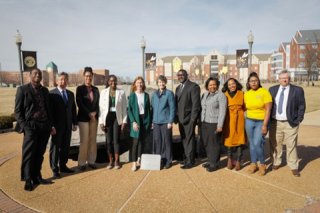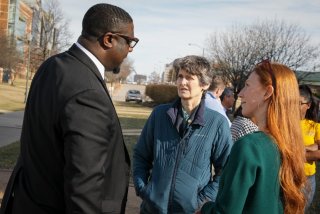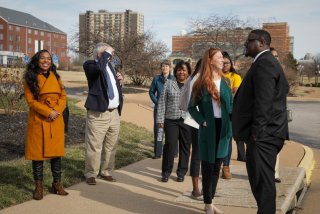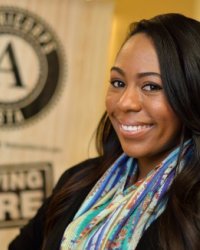The Impacts of Dynamic Partnerships
As an EPA employee, I’ve discovered what it means to meet communities where they are. After joining the Region 7 team, I quickly learned that the relationships and mentorships found within the Communities Section as a project officer to our many grantees are reflected in the the relationships we build within the communities we serve. The EPA’s mission is echoed through our interactions with community members and civic leaders and is evident when we tackle some of our most challenging problems.
Developing Community Relationships
In February 2023, I had the opportunity to attend one of the first foundational meetings for a Memorandum of Understanding (MOU) between Harris-Stowe State University (HSSU) and EPA Region 7.

Harris-Stowe State University is a public historically black university in St. Louis, Missouri. A member-school of the Thurgood Marshall College Fund, HSSU enrolls approximately 1,200 undergraduate students.
An MOU outlines how EPA collaborates and works with partners. The MOU between EPA Region 7 and HSSU was designed to support joint research initiatives; internships and employment opportunities for students; technical assistance; curriculum development support; and collaboration opportunities regarding training, lectures, and seminars.
Harris Stowe State University joins other colleges and universities where EPA Region 7 has successfully implemented similar programs at Lincoln University, Donnelly College, and Haskell Indian Nations University. EPA has several active collaborations with Historically Black Colleges and Universities (HBCUs), Minority Serving Institutions (MSIs), and Tribal Colleges and Universities (TCUs). These collaborations provide strategic opportunities to uplift communities that have long faced marginalization and institutional inequality, and it is impossible to overstate their impact.
Framework for Environmental Justice

The Justice40 Initiative acknowledges historical and ongoing disparities faced by marginalized communities and seeks to prioritize their needs in decision-making processes related to environmental policy, planning, and funding. By doing so, the initiative aims to promote inclusivity, fairness, and sustainability in environmental actions and policies and pave the way for a more just and equitable future for all.
We’re passionate about implementing this framework, and we’re taking a crucial step toward addressing environmental injustice and creating a more sustainable future for communities that have long been marginalized and neglected.
Through the partnerships between EPA and HBCUs, MSIs, and TCUs, Region 7 is dedicated to building on the Justice40 foundation by supporting new research opportunities in otherwise untapped sectors, which can lead to increased community empowerment, engagement, resources, and even employment opportunities.
Continuing to Build on Our Impactful Partnerships

We see our partnerships with these universities as partnerships can secure sustainable practices within communities where they had not been.
Some of the many programs we have implemented through our MOUs are mutually beneficial joint research initiatives; student internships and training that teach future employees and community leaders; and technical assistance such as consultations, workshops, and seminars where we create an accessible space for faculty and students who may need help with environmentally related activities and projects.
In my role at EPA, I continue to seek opportunities to showcase our impactful programs for change in EPA. As a grant project officer, I witness change in real-time and continue to push for these dynamic partnerships filled with shared visions and celebrations of success.

About the Author
Lauryn Joyner
Grants Project Officer
Region 7 Office of Intergovernmental Affairs
Lauryn Joyner is a Grants Project Officer at the EPA’s Region 7 Office of Intergovernmental Affairs, Communities Section. She served three years as both an AmeriCorps Volunteer in Service to America (VISTA) and VISTA Leader at the University of Mississippi. She received a BA in History from Grambling State University, La., a minor in Cinema/ Documentary at the University of Mississippi, Miss., pursued graduate studies in Policy at New York University, N.Y and is a proud Eli J. and Phyllis N. Segal Fellow.
Editor’s Note: The views expressed here are intended to explain EPA policy. They do not change anyone’s rights or obligations. You may share this article. However, please do not change the title or the content, or remove EPA’s identity as the author. If you do make substantive changes, please do not attribute the edited title or content to EPA or the author.
EPA’s official web site is www.epa.gov. Some links on this page may redirect users from the EPA website to specific content on a non-EPA, third-party site. In doing so, EPA is directing you only to the specific content referenced at the time of publication, not to any other content that may appear on the same webpage or elsewhere on the third-party site, or be added at a later date.
EPA is providing this link for informational purposes only. EPA cannot attest to the accuracy of non-EPA information provided by any third-party sites or any other linked site. EPA does not endorse any non-government websites, companies, internet applications or any policies or information expressed therein.
